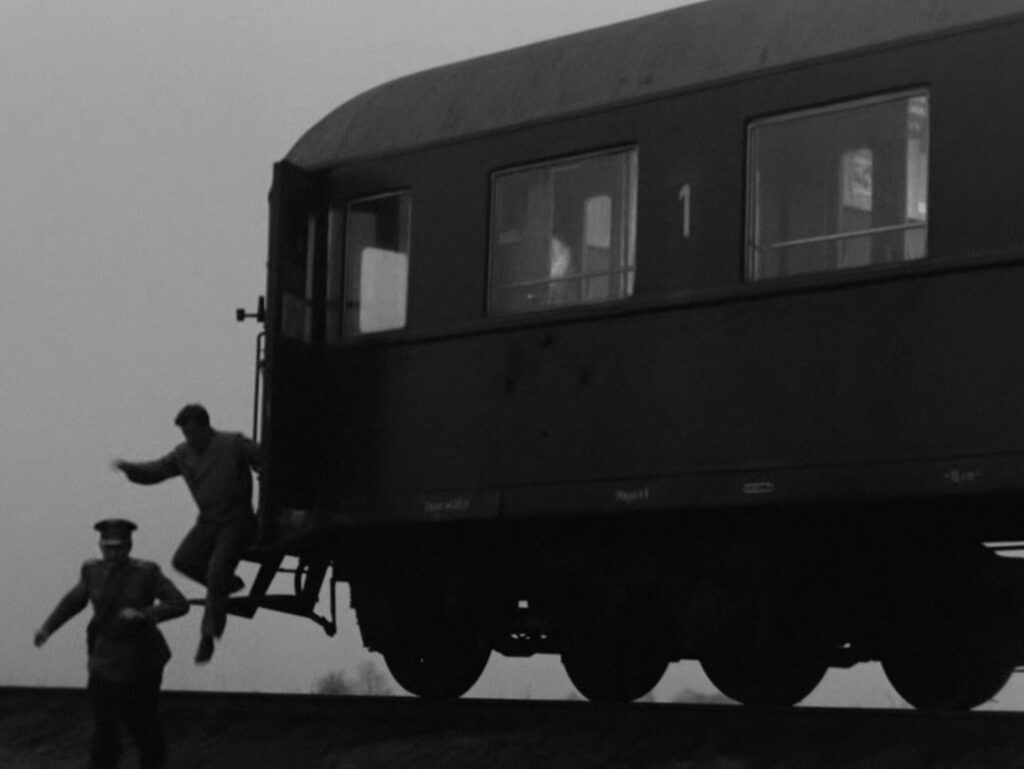
Night Train
1959, directed by Jerzy Kawalerowicz
The action of Night Train can be summarized in ten words: police find a murderer on a train and arrest him. The police and the murderer, though, are all minor characters, and we learn little about the crime and nothing about the killer’s case after his arrest. The movie focuses on the other passengers traveling from Łódź to Hel, but there’s little in their stories that can be called “plot”. The first 52 minutes are given to character development, with hints of romance and conflict between the passengers, but nothing much comes of it. If the plot is so unimportant here, we’re left to wonder what is important.
The most obvious answer would be that Night Train is about the passengers’ reactions to the main event. By all signs the apprehension of the killer makes a strong impression on them, changing their mood and giving them something to remember. It’s the most dramatic event on the journey, and the passengers certainly treat it as dramatic, even before they’re aware that the criminal is riding among them.
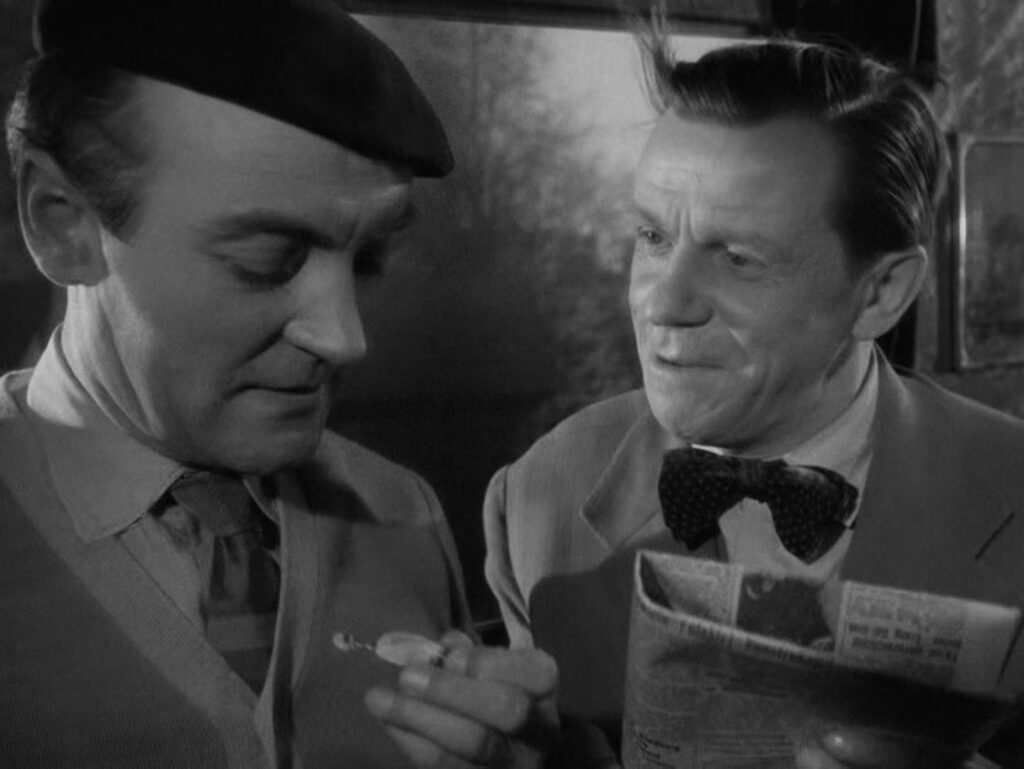
Before the train departs, a vendor sells newspapers through the train windows, and newspapers will appear throughout the film. Sleeper car passengers discuss the paper’s report of the murder. The surgeon, Jerzy, reads a paper, increasing suspicion that he’s the killer. The lawyer fantasizes about defending a murderer (the sort of trial he reads about “in the newspapers”) instead of his usual dull business with mortgage registers. When the train reaches its terminus at the seaside, a gentleman who had slept through most of the night asks for the previous day’s paper. Finally the last frames of the last shot foreground an abandoned newspaper in a train window. The journey is thus bracketed by newspapers, which always hint at the vanity in people’s attraction to sensation and drama.
For most of the passengers, the encounter with the killer represents a rare incursion of drama into their lives, and the film is not flattering about their fascination. They way they follow the police through the crowded train, run after the fugitive through hay fields, and converge on him in the cemetery suggests the reflexive behavior of an unthinking mob. The lawyer’s wife seems to speak for them when she excuses her fascination: “It’s the first time I’ve seen a real murderer.” Until the police come looking for the killer, everyone speaks of him in the abstract. The insomniac theorizes (wrongly) that he will either turn himself in or commit suicide, and the priest speaks of what will happen to his immortal soul. After the police show up, numerous passengers show irrational fear or voyeuristic fascination. Once the killer is encircled in the cemetery, however, a conspicuous gap opens between the idea of the killer and the reality, as the crowd comes face to face with a sad, broken human being. Most of them are sobered, but back on the train one passenger still makes light of it, spinning and shouting like the cornered killer until he sees that no one else is in the mood to joke.
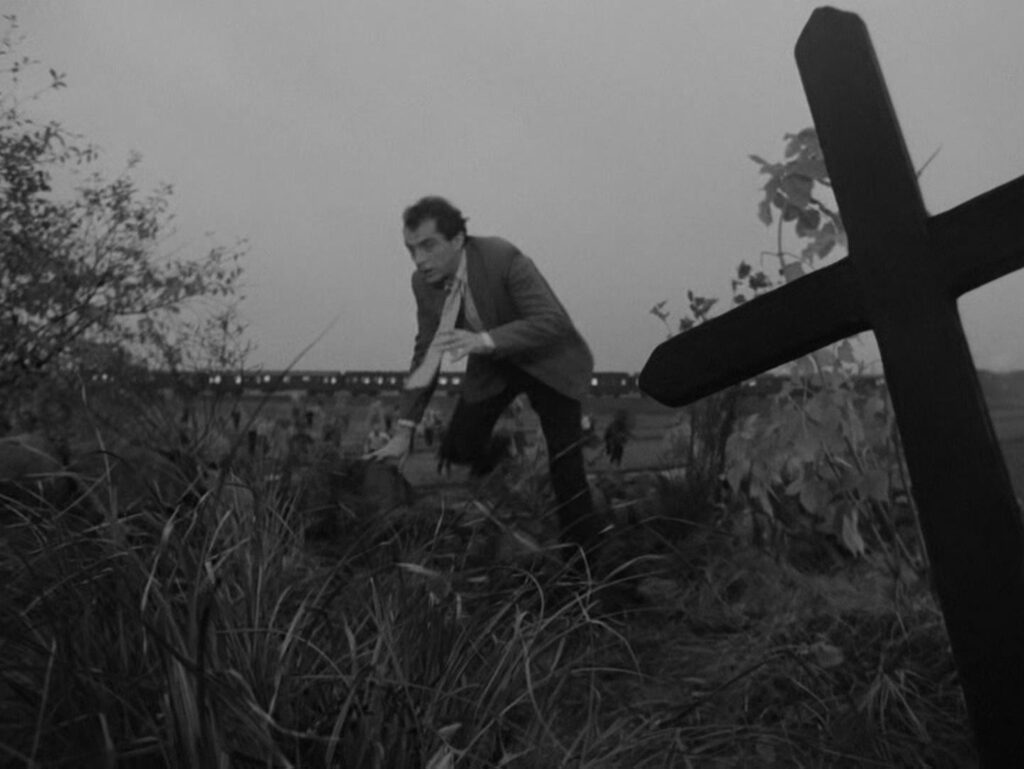
From this point of view, it’s not quite correct to say that Night Train is about humanity’s lust for the sensational. What’s important is not that the passengers experience something dramatic, but that they cross paths with reality itself. Moreover, three of the passengers – the three main characters in fact – never succumb to the prevailing madness, and the reason is clear. Each of them has his or her own encounter with reality to worry about. Jerzy had boarded the train only fifteen minutes after losing a patient, an 18-year-old girl who had jumped from the top floor of a building; Staszek is being rejected by Marta and even has a quick brush with death when she reflexively pushes him back from the window; and Marta is running off to be close to a former lover who’s just written to her.
None of these three shows any signs of fascination with the killer, and not coincidentally they happen to be the only three passengers who interact meaningfully with him. Jerzy is mistaken for him because he occupies berth 16, and he steps in to take the fainted man’s pulse when the mob retreats. Staszek inadvertently draws Marta to the killer’s compartment, and he tackles the man in the cemetery. And Marta, who had bought the criminal’s original sleeper car ticket, identifies him and makes long sympathetic eye contact with him while the crowd stares on.
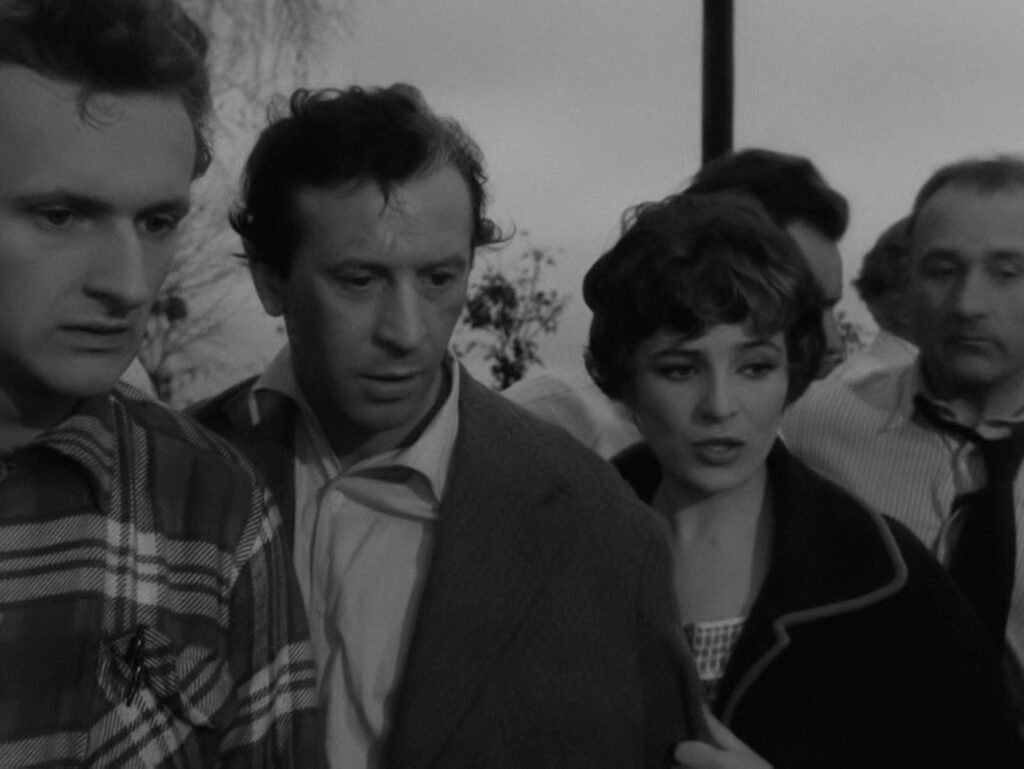
Each of these three main characters faces a private moment of truth, but each looks at it from a different direction. Jerzy’s encounter with reality, his dying patient, is in the recent past. Staszek’s is happening in the present, on the train journey. And Marta, who knows she’ll begin a new life at her destination, is looking to the future. The irony of Night Train is that while its characters are physically traveling in the same direction, their lives at the moment face in multiple, often opposite directions. Most movies spend their time deepening the relationships between major characters, but Jerzy, Staszek, and Marta are swimming at crosscurrents to each other.
The image of crosscurrents is the substance of the opening and closing shots. Night Train begins with hundreds of travelers flowing up and down a wide stairway at the station, the two-minute overhead shot dwelling on their interweaving opposite paths, and the movie ends with two trains passing in opposite directions along the narrow Hel Peninsula. People constantly file past each other in the narrow train aisles, and the dialogue points to the diverse directions of people’s lives – Marta and her former lover, Marek and the insomniac (“Some will stay up tonight, others tomorrow”), and Jerzy’s and Marta’s talk about predicting the future and remembering the past. Jerzy and Marta start out at odds and end up going their separate ways, but they come close for a moment in the middle, almost kissing as the train jerks to a halt to pick up the police. Their compartment is flanked, significantly, by opposite couples: the lawyer and his wife in 13/14 who can’t stand each other, and the young couple in 17/18 who look like honeymooners.
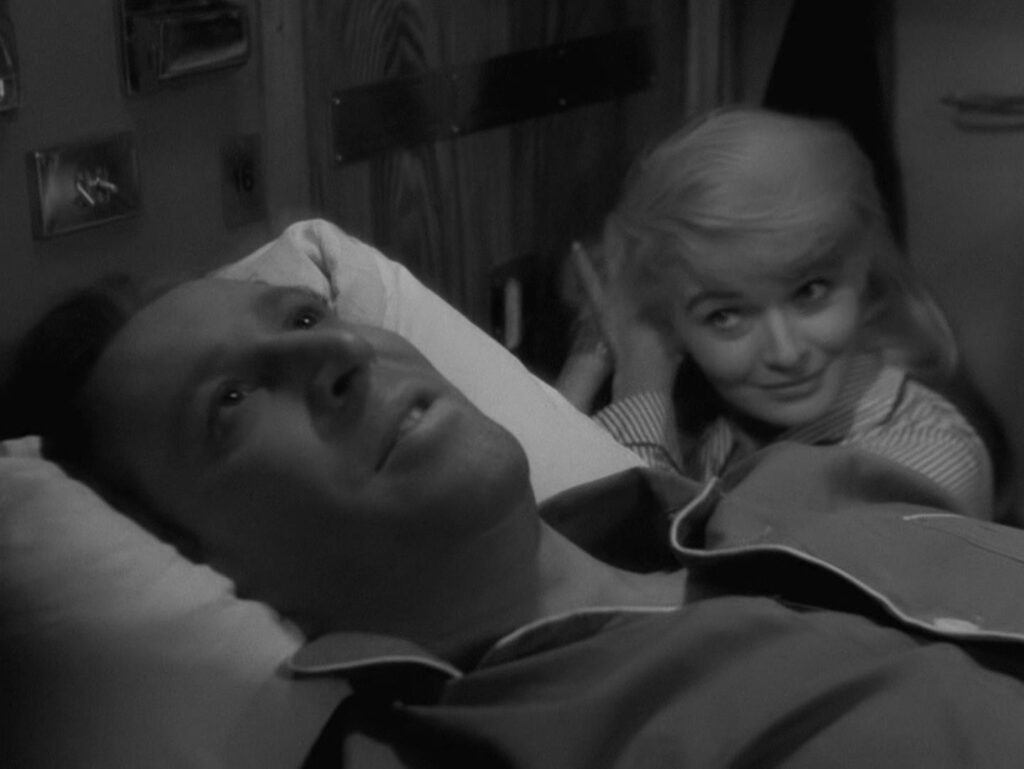
Around the middle of Night Train Jerzy recites a poetic passage that ends with an Indian legend:
“One shouldn’t sit down to a good meal alone,
spend a wakeful night or travel without company,
or be one’s own sole counselor.
Even the humblest traveling companion brings a blessing.
A small crab once saved his companion, a Brahmin, from a viper.”
We should be ready to see now how these words fit the situation. Not only do Jerzy and Marta come together for a fleeting moment as intimate traveling companions – the words also speak to a universal human condition that reflects all the crosscurrents in Night Train. Everyone travels through life alone, often moving against the tide of humanity, but like Jerzy and Marta we have frequent chances for small but meaningful connection. Like that one incident that brings a strange harmony to the whole train, our brief encounters humanize us and heal our intangible wounds, and if we’re wise we can hold onto them for life.
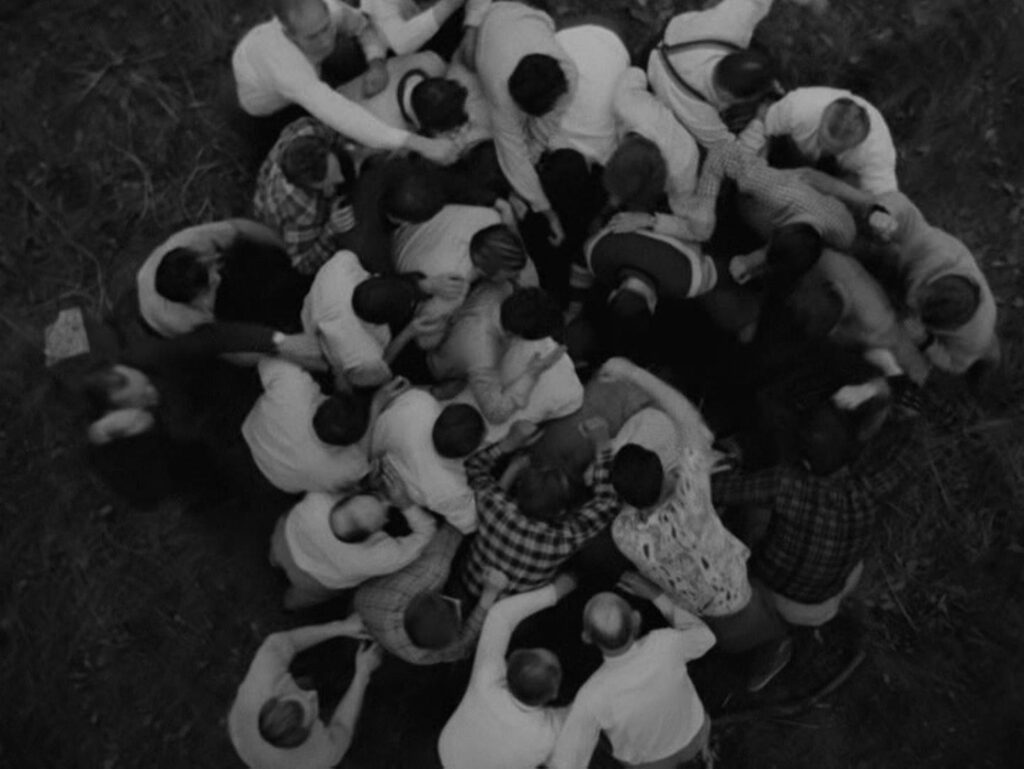
Like the encounter with the murderer, or like the three central characters’ private moments of truth, these transitory connections are also incursions of intense reality. The movie stresses a distinction, however, between dramatic reality and intimate reality. When the passengers go berserk chasing the killer, or when the lawyer’s wife says it’s her first time seeing a “real murderer”, they fetishize reality the same way people do when they watch reality TV shows or when they gawk at an accident. When people equate the dramatic with the “real” they’re generally looking for a substitute for the reality missing from their own lives. The Brahmin in Jerzy’s Indian tale welcomed a small crab with no possible expectation of excitement, but nevertheless the crab saved his life.
CONNECTIONS:
Brief Encounter – Male doctor removes a speck of coal dust from a woman’s eye; doctor later tells the woman that he killed a patient recently (in Brief Encounter it’s a joke)
Tokyo Story – Characters who stand for different directions of time
Cairo Station – Set in or among trains; newspapers represent sensationalism; killer or attempted killer who’s more pathetic than wicked
Pickpocket – Symbolic use of newspapers
L’avventura – Frenzied crowds, de-escalation of the dramatic
La notte – Begins with vertical & ends with horizontal; movement at cross-currents; deprecation of the dramatic; story spans a single night
L’argent – Fetishization of material reality as a crowd gawks at a murderer
The Truman Show – Fetishization of the “real”
NOTE:
Night Train is currently available for free worldwide streaming at 35mm.online. Be sure to set up subtitles using the controls if needed; they are not shown by default. The Cinematograph highly recommends that site for its excellent selection of classic Polish films.